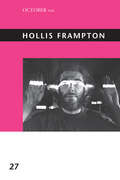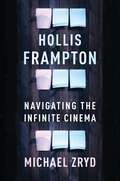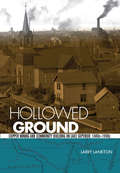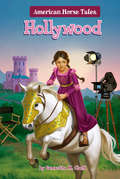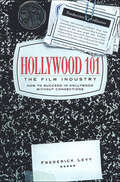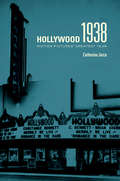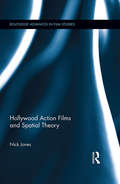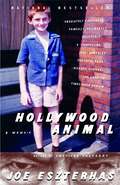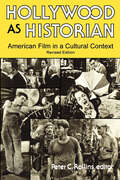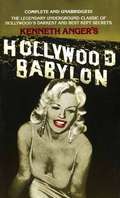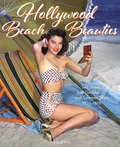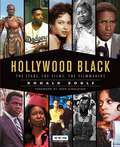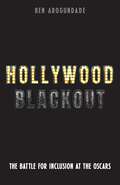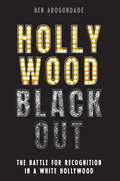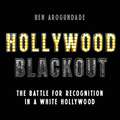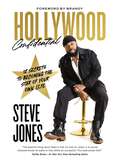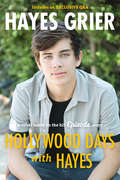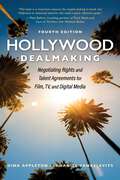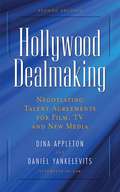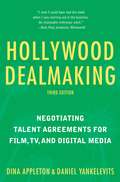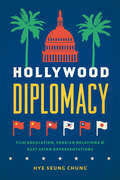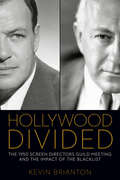- Table View
- List View
Hollis Frampton (October Files #26)
by Michael ZrydThe first collection of critical writing on the work of experimental filmmaker Hollis Frampton.Hollis Frampton (1936–1984) was one of the most important experimental filmmakers and theorists of his time, and in his navigation of artistic media and discourses, he anticipated the multimedia boundary blurring of today&’s visual culture. Indeed, his photography continues to be exhibited, and a digital edition of his films was issued by the Criterion Collection. This book offers the first collection of critical writings on Frampton&’s work. It complements On the Camera Arts and Consecutive Matter, published in the MIT Press&’s Writing Art series, which collected Frampton&’s own writings. October was as central to Frampton as he was to it. He was both a frequent contributor—appearing in the first issue in 1976—and a frequent subject of contributions by others. Some of these important and incisive writings on Frampton&’s work are reprinted here. The essays collected in this volume consider Frampton&’s photographic practice, which continued even after he turned to film; survey his film work from the 1960s to the late 1970s; and explore Frampton&’s grounding in poetics and language. Two essays by the late Annette Michelson, one of the twentieth century&’s most influential writers on experimental film, place Frampton in relation to film and art history. ContributorsGeorge Derk, Ken Eisenstein, Hollis Frampton, Peter Gidal, Barry Goldensohn, Brian Henderson, Bruce Jenkins, Annette Michelson, Christopher Phillips, Melissa Ragona, Allen S. Weiss, Federico Windhausen, Lisa Zaher, Michael Zryd
Hollis Frampton: Navigating the Infinite Cinema (Film and Culture Series)
by Michael ZrydHollis Frampton was an American filmmaker, photographer, and theorist who bridged the experimental film and contemporary art worlds in the 1960s and 1970s. Best known for avant-garde films including Zorns Lemma (1970) and (nostalgia) (1971), Frampton spent his later years working on the unfinished epic Magellan, a monumental cycle that used the metaphor of Ferdinand Magellan’s circumnavigation of the world to rethink the natures and meanings of history, modernity, and cinema. Frampton’s career was cut short by cancer at age 48, with his vast ambitions for the project left incomplete.This book is a groundbreaking and comprehensive account of this remarkable figure’s work in its totality, from Frampton’s earliest films through Magellan. Michael Zryd explores the connections linking Frampton’s art and thought to other media forms, histories, and cultural frameworks. He foregrounds Frampton’s notion of the “infinite cinema,” which redefined the parameters of the medium to encompass all forms of moving image and sound media across the past and future of cinematic possibility. Zryd analyzes Frampton’s ambivalent relationship with modernism and the Enlightenment, showing how the artist navigated between attraction to radical artistic investigation and awareness of this tradition’s implication in colonialism and other oppressive power structures. Shedding new light on Frampton’s project of exploring and critiquing how cinema attempts to capture and understand the world, this book also considers his significance for contemporary art.
Hollowed Ground: Copper Mining and Community Building on Lake Superior, 1840s-1990s
by Larry LanktonDetails a century and a half of copper mining along Upper Michigan's Keweenaw Peninsula, from the arrival of the first incorporated mines in the 1840s until the closing of the last mine in the mid-1990s.
Hollywood #2 (American Horse Tales #2)
by Samantha M. ClarkSet in modern-day California, this American Horse Tale is the story of a young girl who, along with her family's horse, is destined for the big screen.Juniper is a young girl who dreams of making it big in the movies along with her horse, Able. In particular, Juniper is obsessed with getting Able onto her favorite television show, Castle MacAvoy, and will do anything, even slay dragons, to make that happen. Hollywood is part of a series of books written by several authors highlighting the unique relationships between young girls and their horses.
Hollywood 101: The Film Industry
by Frederick LevyLooking for a career in the film business? Look no further.Making it in Hollywood is possible. But only if you have a workable strategy. When author Frederick Levy launched his own fledgling career, he didnt' know a soul in the business. But that didn't stop him and it doesn't have to stop you. Hollywood 101 is a complete game plan for getting your foot in the door of the film industry. With fascinating inside stories and advice from key players, it takes you step-by-step up the ladder of success. Whether you aspire to be a producer, director, writer, talent agent, and any other behind-the-camera professional, this is the one book you need to turn your "reel" dreams into reality!
Hollywood 1938
by Catherine JurcaIn Hollywood 1938, Catherine Jurca brings to light a tumultuous year of crisis that has been neglected in histories of the studio era. With attendance in decline, negative publicity about stars that were "poison at the box office," and a spate of bad films, industry executives decided that the public was fed up with the movies. Jurca describes their desperate attempt to win back audiences by launching Motion Pictures' Greatest Year, a massive, and unsuccessful, public relations campaign conducted in theaters and newspapers across North America. Drawing on the records of studio personnel, independent exhibitors, moviegoers, and the motion pictures themselves, she analyzes what was wrong--and right--with Hollywood at the end of a heralded decade, and how the industry's troubles changed the making and marketing of films in 1938 and beyond.
Hollywood Action Films and Spatial Theory (Routledge Advances in Film Studies)
by Nick JonesThis book applies the discourse of the so-called ‘spatial turn’ to popular contemporary cinema, in particular the action sequences of twenty-first century Hollywood productions. Tackling a variety of spatial imaginations (contemporary iconic architecture; globalisation and non-places; phenomenological knowledge of place; consumerist spaces of commodity purchase; cyberspace), the diverse case studies not only detail the range of ways in which action sequences represent the challenge of surviving and acting in contemporary space, but also reveal the consistent qualities of spatial appropriation and spatial manipulation that define the form. Jones argues that action sequences dramatise the restrictions and possibilities of space, offering examples of radical spatial praxis through their depictions of spatial engagement, struggle and eventual transcendence.
Hollywood Animal: A Memoir
by Joe EszterhasHe spent his earliest years in post WWII-refugee camps. He came to America and grew up in Cleveland--stealing cars, rolling drunks, battling priests, nearly going to jail. He became the screenwriter of the worldwide hits Basic Instinct, Jagged Edge, and Flashdance. He also wrote the legendary disasters Showgirls and Jade. The rebellion never ended, even as his films went on to gross more than a billion dollars at the box office and he became the most famous--or infamous--screenwriter in Hollywood. Joe Eszterhas is a complex and paradoxical figure: part outlaw and outsider combined with equal parts romantic and moralist. More than one person has called him "the devil. " He has been referred to as "the most reviled man in America. " But Time asked, "If Shakespeare were alive today, would his name be Joe Eszterhas?" and he was the first screenwriter picked as one of the movie industry's 100 Most Powerful People. Although he is often accused of sexism and misogyny, his wife is his best friend and equal partner. Considered an apostle of sex and violence, he is a churchgoer who believes in the power of prayer. For many years the ultimate symbol of Hollywood excess, he has moved his family to Ohio and immersed himself in the midwestern lifestyle he so values. Controversial, fearless, extremely talented, and totally unpredictable, the author of the best-selling American Rhapsody and National Book Award nominee Charlie Simpson's Apocalypse has surprised us yet again: he has written a memoir like no other. On one level, Hollywood Animal is a shocking and often devastating look inside the movie business. It intimately explores the concept of fame and gives us a never-before-seen look at the famous. Eszterhas reveals the fights, the deals, the extortions, the backstabbing, and the sex, drugs, and rock'n'roll world that is Hollywood. But there are many more levels to this extraordinary work. It is the story of a street kid who survives a life filled with obstacles and pain . . . a chronicle of a love affair that is sensual, glorious, and unending . . . an excruciatingly detailed look at a man facing down the greatest enemy he's ever fought: the cancer inside him . . . and perhaps most important, Hollywood Animal is the heartbreaking story of a father and son that defines the concepts of love and betrayal. This is a book that will shock you and make you laugh, anger you and move you to tears. It is pure Joe Eszterhas--a raw, spine-chilling celebration of the human spirit.
Hollywood As Historian: American Film in a Cultural Context
by Peter C. Rollins“A commendably comprehensive analysis of the issue of Hollywood’s ability to shape our minds . . . invigorating reading.” ?BooklistFilm has exerted a pervasive influence on the American mind, and in eras of economic instability and international conflict, the industry has not hesitated to use motion pictures for propaganda purposes. During less troubled times, citizens’ ability to deal with political and social issues may be enhanced or thwarted by images absorbed in theaters. Tracking the interaction of Americans with important movie productions, this book considers such topics as racial and sexual stereotyping; censorship of films; comedy as a tool for social criticism; the influence of “great men” and their screen images; and the use of film to interpret history. Hollywood As Historian benefits from a variety of approaches. Literary and historical influences are carefully related to The Birth of a Nation and Apocalypse Now, two highly tendentious epics of war and cultural change. How political beliefs of filmmakers affected cinematic styles is illuminated in a short survey of documentary films made during the Great Depression. Historical distance has helped analysts decode messages unintended by filmmakers in the study of The Snake Pit and Dr. Strangelove. Hollywood As Historian offers a versatile, thought-provoking text for students of popular culture, American studies, film history, or film as history. Films considered include: The Birth of a Nation (1915), The Plow that Broke the Plains (1936), The River (1937), March of Time (1935-1953), City Lights (1931), Modern Times (1936), The Great Dictator (1940), The Grapes of Wrath (1940), Native Land (1942), Wilson (1944), The Negro Soldier (1944), The Snake Pit (1948), On the Waterfront (1954), Dr. Strangelove (1964), Who’s Afraid of Virginia Woolf? (1966), and Apocalypse Now (1979).“Recommended reading for anyone concerned with the influence of popular culture on the public perception of history.” ?American Journalism
Hollywood Babylon: The Legendary Underground Classic of Hollywood's Darkest and Best Kept Secrets
by Kenneth AngerWHITE ELEPHANTS--the God of Hollywood wanted white elephants, and white elephants he got--eight of 'em, plaster mammoths perched on mega-mushroom pedestals, lording it over the colossal court of Belshazzar, the pasteboard Babylon built beside the dusty tin-lizzie trail called Sunset Boulevard.
Hollywood Be Thy Name: The Warner Brothers Story
by Cass W. Sperling Cork Millner Jack WarnerThe Warner Brothers Story: How Harry, Jack, Albert, and Sam Warner immigrated to fabulous wealth, Hollywood riches by founding the Warner Brothers Studio.
Hollywood Beach Beauties: Sea Sirens, Sun Goddesses, and Summer Style 1930-1970
by David WillsA glamorous and nostalgic celebration of the summer through stunning retro photographs of Hollywood beautiesThe author of the acclaimed photo compilations Vegas Gold, Hollywood in Kodachrome, Marilyn Monroe: Metamorphosis, and Audrey: The 60s, now presents a glamorous and nostalgic celebration of summer at the beach, captured in 150 stunning vintage photographs featuring beloved female celebrities, models, and starlets from the 1930s through the 1970s.Renowned independent curator and photographic preservationist David Wills commemorates the allure and joy of the sun, the sand, the ocean, and the fashions of endless summer with this sizzling collection. Hollywood Beach Beauties includes more than one-hundred vibrant color images of some of Hollywood’s most timeless stars lounging and playing at one of the most iconic settings: the beach.Hollywood Beach Beauties highlights the sexy, carefree attitude of the summer, the elegant seaside couture, and the enchanting and alluring beauty of the female form. Included here are candid and stylish photographs featuring stars of yesterday such as Elizabeth Taylor, Rita Hayworth, Audrey Hepburn, Marilyn Monroe, Brigitte Bardot, Sharon Tate, Raquel Welch, Sophia Loren, Dorothy Dandridge, and Nancy Sinatra.A treasure trove for classic movie mavens, vintage photography enthusiasts, and pop culture aficionados, this stunning theme-driven compendium taps into nostalgia for the joys of summer and captures the dazzling beauty of the seaside and some of the most stylish stars of the big screen in a fresh, unique, and captivating way.
Hollywood Black: The Stars, the Films, the Filmmakers (Turner Classic Movies)
by Donald BogleThe films, the stars, the filmmakers-all get their due in Hollywood Black, a sweeping overview of blacks in film from the silent era through Black Panther, with striking photos and an engrossing history by award-winning author Donald Bogle.The story opens in the silent film era, when white actors in blackface often played black characters, but also saw the rise of independent African American filmmakers, including the remarkable Oscar Micheaux. It follows the changes in the film industry with the arrival of sound motion pictures and the Great Depression, when black performers such as Stepin Fetchit and Bill "Bojangles" Robinson began finding a place in Hollywood. More often than not, they were saddled with rigidly stereotyped roles, but some gifted performers, most notably Hattie McDaniel in Gone With the Wind (1939), were able to turn in significant performances.In the coming decades, more black talents would light up the screen. Dorothy Dandridge became the first African American to earn a Best Actress Oscar nomination for Carmen Jones (1954), and Sidney Poitier broke ground in films like The Defiant Ones and 1963's Lilies of the Field. Hollywood Black reveals the changes in images that came about with the evolving social and political atmosphere of the US, from the Civil Rights era to the Black Power movement. The story takes readers through Blaxploitation, with movies like Shaft and Super Fly, to the emergence of such stars as Cicely Tyson, Richard Pryor, Eddie Murphy, and Whoopi Goldberg, and of directors Spike Lee and John Singleton.The history comes into the new millennium with filmmakers Barry Jenkins (Moonlight), Ava Du Vernay (Selma), and Ryan Coogler (Black Panther); megastars such as Denzel Washington, Will Smith, and Morgan Freeman; as well as Halle Berry, Angela Bassett, Viola Davis, and a glorious gallery of others.Filled with evocative photographs and stories of stars and filmmakers on set and off, Hollywood Black tells an underappreciated history as it's never before been told.
Hollywood Blackout: The battle for recognition in a white Hollywood
by Ben ArogundadeOn 29 February 1940, African American actor Hattie McDaniel became the first person of colour, and the first Black woman, to win an Academy Award. The moment marked the beginning of Hollywood's reluctant move toward diversity and inclusion. Since then, minorities and women have struggled to attain Academy Awards recognition within a system designed to discriminate against them. For the first time, Hollywood Blackout reveals the untold story of their tumultuous journey from exclusion to inclusion; from segregation to celebration. Author Ben Arogundade interweaves the experiences of Black actors and filmmakers with those of Asians, Latinos, South Asians, indigenous peoples and women. Throughout the decades their progression to the Oscars podium has been galvanized by defiant boycotts, civil rights protests and social media activism such as #OscarsSoWhite.Whether you are a film fan, history lover or diversity advocate, Hollywood Blackout is the quintessential choice for all those who wish to know the real story of Hollywood, the Oscars and the talents who fought to make change.
Hollywood Blackout: The battle for recognition in a white Hollywood
by Ben ArogundadeOn 29 February 1940, African American actor Hattie McDaniel became the first person of colour, and the first Black woman, to win an Academy Award. The moment marked the beginning of Hollywood's reluctant move toward diversity and inclusion. Since then, minorities and women have struggled to attain Academy Awards recognition within a system designed to discriminate against them. For the first time, Hollywood Blackout reveals the untold story of their tumultuous journey from exclusion to inclusion; from segregation to celebration. Author Ben Arogundade interweaves the experiences of Black actors and filmmakers with those of Asians, Latinos, South Asians, indigenous peoples and women. Throughout the decades their progression to the Oscars podium has been galvanized by defiant boycotts, civil rights protests and social media activism such as #OscarsSoWhite.Whether you are a film fan, history lover or diversity advocate, Hollywood Blackout is the quintessential choice for all those who wish to know the real story of Hollywood, the Oscars and the talents who fought to make change.
Hollywood Blackout: The battle for recognition in a white Hollywood
by Ben ArogundadeOn 29 February 1940, African American actor Hattie McDaniel became the first person of colour, and the first Black woman, to win an Academy Award. The moment marked the beginning of Hollywood's reluctant move toward diversity and inclusion. Since then, minorities and women have struggled to attain Academy Awards recognition within a system designed to discriminate against them. For the first time, Hollywood Blackout reveals the untold story of their tumultuous journey from exclusion to inclusion; from segregation to celebration. Author Ben Arogundade interweaves the experiences of Black actors and filmmakers with those of Asians, Latinos, South Asians, indigenous peoples and women. Throughout the decades their progression to the Oscars podium has been galvanized by defiant boycotts, civil rights protests and social media activism such as #OscarsSoWhite.Whether you are a film fan, history lover or diversity advocate, Hollywood Blackout is the quintessential choice for all those who wish to know the real story of Hollywood, the Oscars and the talents who fought to make change.
Hollywood Blackout: The battle for recognition in a white Hollywood
by Ben ArogundadeOn 29 February 1940, African American actor Hattie McDaniel became the first person of colour, and the first Black woman, to win an Academy Award. The moment marked the beginning of Hollywood's reluctant move toward diversity and inclusion. Since then, minorities and women have struggled to attain Academy Awards recognition within a system designed to discriminate against them. For the first time, Hollywood Blackout reveals the untold story of their tumultuous journey from exclusion to inclusion; from segregation to celebration. Author Ben Arogundade interweaves the experiences of Black actors and filmmakers with those of Asians, Latinos, South Asians, indigenous peoples and women. Throughout the decades their progression to the Oscars podium has been galvanized by defiant boycotts, civil rights protests and social media activism such as #OscarsSoWhite.Whether you are a film fan, history lover or diversity advocate, Hollywood Blackout is the quintessential choice for all those who wish to know the real story of Hollywood, the Oscars and the talents who fought to make change.
Hollywood Blockbusters: The Anthropology of Popular Movies
by Peter Wogan David SuttonCertain Hollywood movies are now so deeply woven into the cultural fabric that lines of their dialogue - for example, 'Make him an offer he can't refuse' - have been incorporated into everyday discourse. The films explored in this book, which include The Godfather, Jaws, The Big Lebowski, Field of Dreams and The Village, have become important cultural myths, fascinating windows into the schisms, tensions, and problems of American culture. Hollywood Blockbusters: The Anthropology of Popular Movies uses anthropology to understand why these movies have such enduring appeal in this age of fragmented audiences and ever-faster spin cycles. Exploring key anthropological issues from ritual, kinship, gift giving and totemism to literacy, stereotypes, boundaries and warfare, this fascinating book uncovers new insights into the significance of modern film classics for students of Film, Media, Anthropology and American Cultural Studies.
Hollywood Confidential: 12 Secrets to Becoming the Star of Your Own Life
by Steve JonesHow long will you wait to live your dreams? Maybe you're just starting out and are unsure where to invest your time and energy. Maybe you've started and stopped so much already that your fallback plan has become the only plan. Maybe you've simply lost touch with your creative self. In Hollywood Confidential, Steve Jones shares his twelve secrets to success accrued from working alongside some of today's most powerful voices in entertainment.Known for production successes such as Jennifer Lopez's first holiday visual and the Oprah Winfrey Network's record-breaking #1 docuseries Black Love, Steve knows the endurance and optimism it takes to pursue your passion. In Hollywood Confidential, he dishes out inspiration from his two-decade L.A. career and what he has learned from the megastars he's worked with and admired. Inside you'll find:Practical suggestions for silencing your inner critic, making the most of failures, and giving yourself permission to shineMotivating ideas to help you live out your purpose, extracted from the case studies and success stories of twelve of Hollywood&’s top actors and personalities that Steve has produced in TV/Media, or interviewed on his platform including Issa Rae, Tabitha Brown, Regina King, Angela Bassett, and moreAffirmations to keep you going as you cast a vision for who you want to becomeThought-provoking questions for reflection at the end of every chapterStrategies for anyone dreaming of moving out of the shadows, into the spotlight and leading role of their life Full of unforgettable wisdom and powerful perspective from industry leaders, Hollywood Confidential is the perfect gift for:Those who are looking to discover their purpose in lifeEveryone who has a dream to live their best, most authentic lifeThe self-made creative looking to make their mark on the worldAnyone eager to break into the entertainment or music industriesFans of Steve Jones&’s popular event series Hollywood ConfidentialReaders who enjoy anecdotes and advice from today's industry leaders It's time to take your place at the center of your life's stage. Hollywood Confidential is the jolt of encouragement you need to embrace your creative self, your biggest dreams, and your innate desire to live a fulfilled, satisfying life.
Hollywood Days with Hayes: A Novel Based on the Hit Episode Story
by Hayes GrierTwelve days and twelve nights in Hollywood with Hayes. Hayes Grier has just landed his first big Hollywood role, the lead in a big budget blockbuster film. There he meets Violet Reeves, an aspiring writer, who has also been given her first big break. If she aces her new job as Hayes's assistant on the film, which means making sure he is on time, knows his lines, and doesn't get himself killed, the director will read Violet's own screenplay. The only problem? Violet has a huge crush on Hayes. She has to keep her emotions in check, impress Hayes, and add some heart to her script. But what about Violet's heart? Does Hayes feel the same way about Violet as she does about him? Social media superstar Hayes Grier sets this story, based on the hit story on Episode (the world's largest interactive storytelling app), during the hot days and long nights of a Hollywood shoot. In addition to this novel, fans will get an exclusive, never-before-seen Q&A with Hayes, A Perfect Day with Hayes, and some family photos!
Hollywood Dealmaking: Negotiating Rights and Talent Agreements for Film, TV, and Digital Media
by Dina Appleton Daniel Yankelevits&“This book is a must-have resource for anyone looking to break into Hollywood or seasoned veterans who need a quick reference guide.&”––Matt Belloni, Puck founding partner and host of The Town The legal resources of studios and networks are legendary, often intimidating independent producers, writers, actors, directors, agents, and others as they try to navigate through the intricate maze in negotiations. This invaluable reference presents the interests of talent as well as the point of view of creative executives, producers, entertainment attorneys, agents and managers, and major guilds—making clear the role that each plays in the deal-making process. Readers will find expert insights to talent and production deals for television, feature film, major streaming platforms, and other digital media, as well as an in-depth overview of net profits and other forms of contingent compensation. Hollywood Dealmaking, Fourth Edition, also addresses changes resulting from new union agreements, and the evolution in deals as worldwide streaming platforms and FAST channels erode the past dominance of cable and linear television. In addition, this comprehensive guide includes: Basics of copyright law and impacts of recent legislation and court decisions on the deal-making landscape New section on non-writing executive producer (NWEP) deals Explanations of employment deals Details of rights acquisition Sample contracts and forms Timely new negotiating tips on the evolving landscape straight from industry insiders Deal considerations of new technologies such as generative AI Glossary of industry lingo and terminology And much more! Peppered with facts on the deals of superstar players and with summaries in each section to clarify complex legal issues, Hollywood Dealmaking is an essential resource for industry novices and veterans alike who want to sharpen their negotiation skills and successfully close each deal.
Hollywood Dealmaking: Negotiating Talent Agreements
by Dina Appleton Daniel YankelevitsHollywood Dealmaking has become the go-to resource for new and experienced entertainment attorneys, agent trainees, business affairs executives, and creative executives. Entertainment attorneys and Hollywood insiders Dina Appleton and Daniel Yankelevits explain the negotiation techniques and strategies of entertainment dealmaking and detail the interests and roles of producers, writers, actors, directors, agents, and studio employees in crafting a deal. This new edition captures the dramatic changes over the past five years in the film and television industry landscape, with two new chapters: Reality Television details the sources of revenue, syndication possibilities, and format sales of these shows as well as the talent deals that are made and the Internet/New Media chapter delves in new digital formats such as mobile phones, game consoles, video-on-demand, and web-based apps, and explains where today's revenues are generated, where the industry is headed, and talent negotiation issues. All the ins and outs of negotiating are explained, including back ends, gross and adjusted gross profits, deferments, box office bonuses, copyrights, and much more. This easy-to-follow reference is packed with expert insights on distribution, licensing, and merchandising. The book's invaluable resource section includes definitions of lingo for acquisition agreements and employment deals, twelve ready-to-use sample contracts, and a directory of entertainment attorneys in both New York and Los Angeles. In Hollywood Dealmaking, readers will recognize the key players in the process, understand the "lingo" of crafting deals, learn how to negotiate agreements for the option and purchase of books and screenplays, be able to negotiate employment deals for all members of a film or television crew, understand payment terms and bonuses, and be able to register copyrights in scripts and other literary works.
Hollywood Dealmaking: Negotiating Talent Agreements for Film, TV, and Digital Media (Third Edition)
by Dina Appleton Daniel Yankelevits"I wish I could have had this book when I was starting out in the business. An invaluable reference work." —Alan Poul, producer, Westworld The legal resources of studios and networks are legendary, often intimidating independent producers, writers, actors, directors, agents, and others as they try to navigate through the maze of legal details. This invaluable reference presents the interests of talent as well as the point of view of creative executives, producers, entertainment attorneys, agents and managers, and major guilds—making clear the role that each plays in the dealmaking process. Readers will find expert insights to talent and production deals for television, feature film, video, and the Internet, as well as an in-depth overview of net profits and other forms of contingent compensation. Hollywood Dealmaking, Third Edition, also addresses digital and new platforms, changes resulting from new union agreements, and the evolution in feature film back-end (profit participation) deals. In addition, this comprehensive guide includes: Explanations of employment deals Details of rights acquisition Basics of copyright law Sample contracts and forms Glossary of industry lingo and terminology And much more! Peppered with facts on the deals of superstar players and with summaries in each section to clarify complex legal issues, Hollywood Dealmaking, Third Edition, is an essential resource for industry novices and veterans alike who want to sharpen their negotiation skills and finalize the deals they have been seeking.
Hollywood Diplomacy: Film Regulation, Foreign Relations, and East Asian Representations
by Hye Seung ChungHollywood Diplomacy contends that, rather than simply reflect the West’s cultural fantasies of an imagined “Orient,” images of Chinese, Japanese, and Korean ethnicities have long been contested sites where the commercial interests of Hollywood studios and the political mandates of U.S. foreign policy collide, compete against one another, and often become compromised in the process. While tracing both Hollywood’s internal foreign relations protocols—from the “Open Door” policy of the silent era to the “National Feelings” provision of the Production Code—and external regulatory interventions by the Chinese government, the U.S. State Department, the Office of War Information, and the Department of Defense, Hye Seung Chung reevaluates such American classics as Shanghai Express and The Great Dictator and applies historical insights to the controversies surrounding contemporary productions including Die Another Day and The Interview. This richly detailed book redefines the concept of “creative freedom” in the context of commerce: shifting focus away from the artistic entitlement to offend foreign audiences toward the opportunity to build new, better relationships with partners around the world through diplomatic representations of race, ethnicity, and nationality.
Hollywood Divided: The 1950 Screen Directors Guild Meeting and the Impact of the Blacklist (Screen Classics)
by Kevin Brianton“Brianton’s well-documented study of a Hollywood controversy delves into one example of the post-WWII Red Scare” (Publishers Weekly).On October 22, 1950, the Screen Directors Guild (SDG) gathered for a meeting at the opulent Beverly Hills Hotel. Among the group’s leaders were some of the most powerful men in Hollywood—John Ford, Cecil B. DeMille, Joseph L. Mankiewicz, John Huston, Frank Capra, William Wyler, and Rouben Mamoulian—and the issue on the table was nothing less than a vote to dismiss Mankiewicz as the guild’s president after he opposed an anticommunist loyalty oath that could have expanded the blacklist. The dramatic events of that evening have become mythic, and the legend has overshadowed the more complex realities of this crucial moment in Hollywood history.In Hollywood Divided, Kevin Brianton explores the myths associated with the famous meeting and the real events that they often obscure. He analyzes the lead-up to that fateful summit, examining the pressure exerted by the House Un-American Activities Committee. Brianton reveals the internal politics of the SDG, its initial hostile response to the HUAC investigations, the conservative reprisal, and the influence of the oath on the guild and the film industry as a whole. Hollywood Divided also assesses the impact of the historical coverage of the meeting on the reputation of the three key players in the drama.Brianton’s study is a provocative and revealing revisionist history of the SDG’s 1950 meeting and its lasting repercussions on the film industry as well as the careers of those who participated. Hollywood Divided illuminates how both the press's and the public's penchant for the “exciting story” have perpetuated fabrications and inaccurate representations of a turning point for the film industry.Huffington Post Best Film Books of 2016Praise for Hollywood Divided“An authoritative reassessment of the meetings held by the Screen Directors Guild in 1950 to consider the adoption of a loyalty oath. Brianton traces the implications for the film industry and the reputations of key filmmakers, including Cecil DeMille and John Ford. He also offers sharp and illuminating reflections on the making of Hollywood history and myth.” —Brian Neve, author of The Many Lives of Cy Endfield: Film Noir, the Blacklist and Zulu“A breakthrough book on a topic that historians, for the most part, have considered settled. Brianton’s landmark study is fresh, thorough, and balanced, a model of Hollywood historiography. In clear prose, he takes the reader through the detailed twists and turns that created both the myth and the subsequent legend of the fateful Directors Guild Meeting that occurred during a critical time in American history.” —James D’Arc, Curator, Cecil B. DeMille Papers, Brigham Young University
